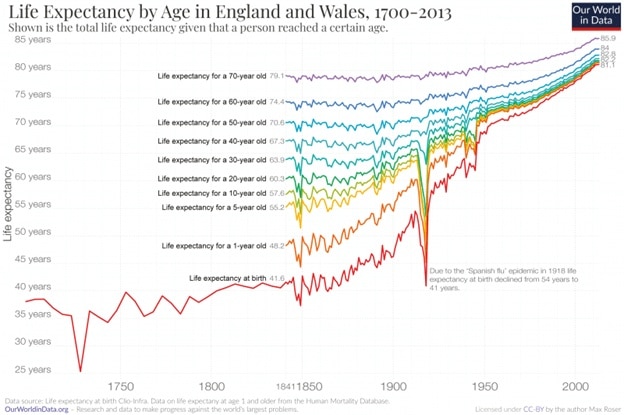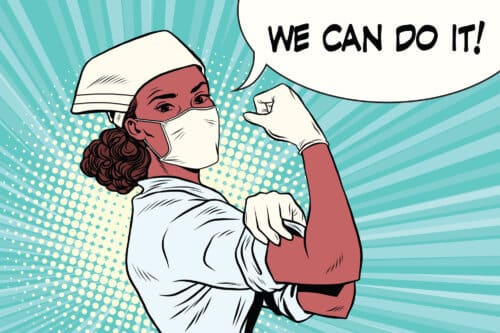When the next dangerous virus is released into the world's air, it will find a deep moat courtesy of science that will make it possible to understand its operation, and a wall in the form of technology that will stop it. The way the virus works will be deciphered within a day. The drugs and vaccines will be developed within a week, with minimal clinical trials thanks to the precision of the cell and body simulations

Let's go back a few years: in 1800, the global life expectancy was around thirty years. There was not a single country where life expectancy rose beyond forty years. A hundred years later, in 1900, what was the life expectancy in the most advanced country in the world - Great Britain?
Only forty-six years.
Let's explain for a moment what the term "life expectancy" means: it is the average number of years a person born in that year is expected to live. The emphasis is on the word average. People didn't live forty-six years and then puff up their souls. It's just that the children - the main victim of infectious diseases - died en masse at a young age. In England in 1900, 15 percent of all babies died in their first year of life. These figures dragged the average down, but if you were lucky and reached the age of twenty, then your life expectancy was 60 years.
It was then. today is the day. Life expectancy in the UK has almost doubled to 81.4 years. The longevity records are Hong Kong and Japan, where life expectancy is 84.9 years.
Let's look at Britain again, as it is one of the countries with the most reliable health records over the last few centuries. In 1850, nearly fifty percent of all deaths in Britain were due to communicable diseases. Tuberculosis alone killed fifteen percent, scarlet fever and diphtheria almost six percent each. There were almost no heart attacks, strokes or cancer. Very few people live to an age where they will suffer from the diseases of aging.
Today, most citizens of the developed world die from diseases of old age such as cancer, heart disease and diabetes, and not from infectious diseases, at least until a year ago.
Why? What changed?
The answer can be divided into three stages: technology, science and again technology.

Science, technology, science
Technology is a tool that man invented for his needs. The sword is a technological product, as is the shield. But social constructs such as laws and common ways of behaving are also technology - invisible tools that exist only thanks to the collective soul that recognizes them. The engineers know very well that technology can get ahead of science, that practice can bridge gaps in knowledge, that masking tape is sometimes more successful than any initial scientific theory.
We were able to stop the Black Death - the Yersinia pestis bacterium that killed at least a third of the European population in the 14th century - thanks to technology. Without understanding its nature, we developed strict monitoring and containment measures. During the Renaissance period we systematically developed and implemented closures, isolation areas and even contact tracing[1]. Britain needed time - then as today - to adopt these technological tools, and experienced four more major plagues by the end of the 17th century. The rest of Europe was saved thanks to technology. But technological tools are quickly abandoned when they are not needed, and without a proper scientific theory, it is difficult to "transfer knowledge" from one field to another.
Another example: in 1798, Edward Jenner discovered that a primitive vaccine - inoculation - could be performed against smallpox. But this too was technology, a mere tool without the necessary knowledge to expand it to other fields. Without a true understanding of why the vaccine works, it remained isolated for almost a hundred years and saved many millions from death. And yet, the contagious childhood diseases, rubella and mumps and measles and pertussis, remained widespread throughout Europe, without a vaccine being found for them.
The second stage was not long in coming: the scientific understanding. One after the other throughout the 19th century, scientists appeared who made it clear to us how viruses and bacteria behave. Without those scientists like Louis Pasteur we would not know about the full meaning of viruses. The same Louis Pasteur, by the way, who prophesied in the middle of the 19th century that a day would come when children would no longer die from infectious diseases - and was ridiculed by all his contemporaries. Without researchers like Heinrich Hermann Koch or Joseph Lister, we would not understand how diseases spread and how to identify - and neutralize - the bacteria and viruses responsible for them.
From the heights of our time, we tend to underestimate the lack of knowledge from the past. We take for granted the idea that microorganisms cause disease, and therefore we must find ways to fight them. We forget that for those who lived in the past, this idea was only one of many that explained the origin of diseases, such as the spontaneous creation of bacteria out of nowhere, or particles of pollution that are only found in certain places.
Thanks to the scientific method, we were able to understand what the real causes of diseases are, and from there it was a short way to deal with them.
Then came the third stage: the technology, again.
Armed with scientific understanding, we created technological tools that prevented infection with the cholera bacteria. In three words: toilets and sewage systems.
We have developed tools to prevent bacterial infection: sterilization of surgical instruments. Sound obvious? In two hundred-thousand years of human existence, we have not come to this understanding. Sterilization technologies have saved the lives of hundreds of millions of people, and continue to do so to this day.
We discovered and improved penicillin. The significance of antibiotics would not be recognized at all if we were not armed with knowledge about bacteria. Alexander Fleming was not thrilled that fungi killed bacteria that have nothing in common with disease. And the second hero whose name is almost never mentioned in the stories, Howard Florey, would not perfect the antibiotic identified by Fleming - whose price was many times higher than its weight in gold - so that it became available to everyone.
Once we solved the mystery of bacteria, we also found a solution for it. Science provided us with the direction, and technology - the weapon we aimed at the bacteria.
And how will we use science and technology to deal with the next epidemics?

The victory over nature
The first major disease we managed to eradicate from the face of the earth was smallpox. This happened thanks to the combination of science and technology. Technology has provided us with effective vaccines. Science gave us the knowledge about the ways the virus spreads and the possibilities for mutations, so we didn't have to vaccinate every person on earth, but we could focus on outbreak points and understand how to vaccinate people optimally to stop the spread of the epidemic.
I repeat: we, humans, used the intellectual tools and knowledge accumulated over hundreds of years, to eradicate from the world a virus that killed hundreds of millions of people for thousands of years. we won There is no other word to describe this achievement. And he should excite, pulsate, each of us, because he is only the swallow that heralds the coming of spring.
Science and technology will continue to advance. Philosopher Jose Ortega y Gast wrote in his book "The Revolt of the Masses" with amazement, because we all know at the most basic intuitive level that science and technology will not stop their development. Everyone is sure that televisions will become more sophisticated, that new generations of smartphones will continue to emerge every year. This has not always been the case throughout history, but such is the case today. Science and technology, interwoven with each other, will not remain silent as long as humans want to achieve more: a higher quality of life, freedom from disease, freedom from the small and limited ball of mud we live on, freedom from death.
In other words, scientific and technological development will never stop.
There is a feedback loop between the two: technology accelerates scientific progress, and it in turn provides a basis for new technologies. Even in the past it was like this: we could not disprove the idea of spontaneous creation, which claimed that bacteria were created out of nothing, without sealed glass jars and advanced sterilization technologies. We would not have been able to discover the bacteria without the lens carving technology and the basic microscope developed by Antony van Leeuwenhoek. Then, thanks to the science of optics, we made the lenses even more sophisticated.
These days we are experiencing faster progress than ever in science and technology. The reason is that technology is leaping forward in its ability to provide new scientific insights. In the past year alone, advanced artificial intelligence has recently succeeded in solving the puzzle of protein folding, which has accompanied biology for the past fifty years, better than any human[2]. They were able to develop a successful new ecological model to explain the distribution of species in the ocean and islands[3]. They mapped the brain of a fruit fly at the resolution of single synapses[4]. Technion researchers have developed artificial intelligence that provides answers to age-old mathematical problems[5].
And the most important: artificial intelligences have succeeded in recent years in developing new artificial intelligences that are more effective than human-made artificial intelligences[6]. And as defined by an article in the respected magazine Science - "artificial intelligence develops by itself". This is an exaggeration - we still need people - but it is not as big as we would like to think.
This means that the rate of accumulation of scientific knowledge is going to grow by leaps and bounds in the coming years, and technology will not be far behind. In the coming decades we will see artificial intelligence that is able to analyze the structure of new viruses in a matter of minutes. We envision artificial intelligence running on quantum computers or any other computing paradigm that will develop at the same time. These will be able to run advanced simulations of the entire body, in order to understand the full effect of this or that virus on the body - as well as the effects of new drugs or vaccines. We will see artificial doctors providing advice with a precision that surpasses that of the average human doctor, and autonomous robots performing surgeries with a level of precision that a human surgeon could only envy.
All these together imply that when the next dangerous virus is released into the world's air, it will find a deep moat courtesy of science that will make it possible to understand its action, and a wall in the form of technology that will stop it. The way the virus works will be deciphered within a day. The drugs and vaccines will be developed within a week, with minimal clinical trials thanks to the precision of the cell and body simulations.
All this is not a fantasy detached from reality. If you believe in the progress of science and technology, if you believe that artificial intelligence can accelerate that progress, then you should also accept this future.
Too optimistic? I am?
Do I sound too optimistic to you? Your'e right. There are also great dangers. Who, like the people of Israel, knows that science and technology can serve the few at the expense of the many. There are challenges we must solve to bring about a responsible and balanced advancement of technology, to ensure that science is not used as a way to justify man-made atrocities. But as the futurist and thinker Stuart Brand says: I am a pessimist and an optimist. I am pessimistic in the short term, because someone needs to shed light on the dangers. I am optimistic in the long term, because until now we as humanity have been able to deal with those dangers, once we understood their meaning.
And if you allow me to continue to be optimistic, then in the long run, after the middle of the 21st century, when we finish defeating the infectious diseases, the time will also come for the other diseases that have accompanied the human race since time immemorial: cancer, heart diseases and strokes, neurodegenerative diseases and many others. Provided we face the dangers, science and technology will not stop advancing until they help us find an answer to all the great problems of existence.
And if there's one thing I can guarantee you, it's that it will be much more detailed than 42.
[1] https://www.amazon.com/Reason-Plague-Seventeenth-Century-Tuscany/dp/0393000451
[2] https://www.nature.com/articles/d41586-020-03348-4
[3] https://www.frontiersin.org/articles/10.3389/fevo.2020.530135/full
[4] https://www.janelia.org/project-team/flyem/hemibrain
[5] https://www.nature.com/articles/s41586-021-03229-4.epdf
[6] https://www.sciencemag.org/news/2020/04/artificial-intelligence-evolving-all-itself
